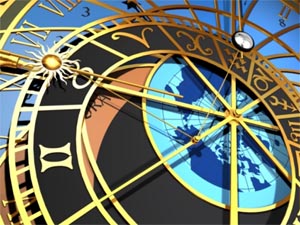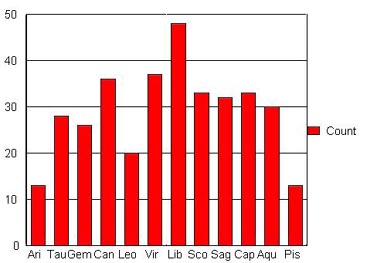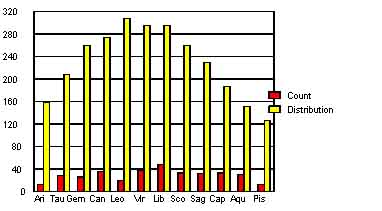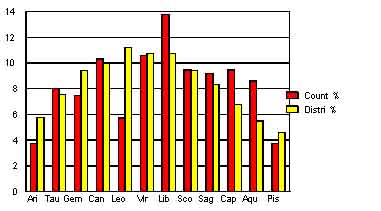Apr 14, 2025
Apr 14, 2025
 Research in jyotish is becoming quite the common endeavor these days. It ranges from the statistical end to the exploratory end of the spectrum of the term research. Both ends have their problems. At the statistical end, one of the biggest problem is the unavailability of database resources, to most individuals. Commercial databases are extremely expensive and have their limitations when used by jyotish researchers; however, any serious number crunching would require one to have a decent collection of birth data and charts with biographical details and the software must have some sort of searching and pattern recognition ability. It is not uncommon and by no means a new trend amongst jyotishis to put too much emphasis on their own charts or of their few relatives and friends. While important, this meager database of a few dozen charts is simply not adequate and sadly deceptive.
Research in jyotish is becoming quite the common endeavor these days. It ranges from the statistical end to the exploratory end of the spectrum of the term research. Both ends have their problems. At the statistical end, one of the biggest problem is the unavailability of database resources, to most individuals. Commercial databases are extremely expensive and have their limitations when used by jyotish researchers; however, any serious number crunching would require one to have a decent collection of birth data and charts with biographical details and the software must have some sort of searching and pattern recognition ability. It is not uncommon and by no means a new trend amongst jyotishis to put too much emphasis on their own charts or of their few relatives and friends. While important, this meager database of a few dozen charts is simply not adequate and sadly deceptive.
The other kind of research is the exploratory kind and deals with looking for unique ‘astrosignatures’ or tags as they are sometimes called. Traditional tags are basically all the yogas such as gajkeshari or mahapurusha yogas and the umpteen other combinations for fame, fortune and generally known as yogas and the signatures for misery or penury known as doshas or arishtas. The exploration can be of existing combinations or even into novel territory. Either way, it is easy to imagine how important it is to have a utility that would allow one to test the combination in not one or two or even two dozen charts but in hundreds of horoscopes.
It is very human to dream, to want the best, and to make the most out of every little effort or thing. It is quite commonly seen in astrology, where individuals begin to get obsessively fixated on a given factor in a horoscope or in general in their practice of astrology. Often, this happens in their own charts where they tune into a particularly beneficial or malefic combination and then try to explain everything or at least a LOT based on that single factor at the risk of ignoring other important indicators in the charts, ultimately overlooking to a certain extent – the obvious reality! There are many astrologers, even good ones, who feel this subjective need to see it all happen in their charts before they are convinced of the significance of the factor or combination under study. Nothing wrong with the approach, but unfortunately, over a long period of time, this does begin to cloud one’s judgment – at least some of the times, when the astrologer is a bit vulnerable, and things are not going the way he wished them to or –worse– had so ‘foreseen’ and now must find props for his ego. Being passionate is good, but pet theories that begin to drive one’s sense of reality can have some serious drawbacks.
A couple of years ago, there was a discussion going on what combinations are necessary for making one an astrologer. A number of combinations were proposed by the participants, mostly not even with classical citations, though implicitly claimed to be so. One combination which was very simple was cited as a possibility, with all the caveats. Immediately one experienced person jumped on this and provided a few examples of well-known nativities who were obviously non-astrologers but had such a combination. Some astrologers were used as examples of situations without the said combination. Then a statement was made that rashi drishti should not be used for research because it was Jaimini and not Parashari, although it prominently appears in BPHS, the mammoth magnum opus attributed to Sage Parashara! This kind of ‘logic’ that one should not consider Parashari and Jaimini rules together, as verbalized by this individual gets ridiculous because the same planet probably does not switch its Parashari hat with its Jaimini hat when it wants to express/indicate some astrological effects, or does it? This astrologer also claimed that he had tested the combination in about five hundred charts of astrologers he had and did not find it to work. He did not elaborate on the details of the charts and everything hung on ‘trust’ which could not be challenged out of politeness towards his advanced age, etc.
This kind of situation is fairly common and simply irrational and unacceptable, if we are all after the truth. Imagine how things would go if a scientist claims he has found a wonder drug and does not elaborate on it or the tests he had conducted on the new medicine and expected other doctors to begin using it on their patients! Anyway, without going into any comparison of scientists and astrologers, which some from both camps may find distasteful, this kind of inadequate information exchange is not acceptable and cannot work in a research setting. To complicate further, there is a lot of distrust and not insignificant amount of politics in the astrological scene and many do not like to share their databases with others, partly for personal reasons (confidentiality of clients or simple possessiveness and information hoarding) or for allegedly ‘malefic’ past experiences when shared or declared birth data had been distorted under the garb of “rectification” and the picture made even more confusing and garbled than it started out to be. My general impression of having followed the scene for now at least 25 years in print, on the web and discussions is that the tropical astrologers have fewer of these personal and personality problems and are infinitely better and more advanced at information sharing and dissemination than the jyotishis. Perhaps because many of them, at least the researchers, come from scientific and technical backgrounds or it might just reflect their personal qualities, I do not know.
Leaving aside greedy or malicious intent and display thereof, jyotishis being simply ordinary mortals, one and all, there is sadly an ignorance or at least unawareness regarding the tricks that ‘numbers’ can play on our perception! One common tendency is that of many individuals of feeling pressured into giving specific percentage values even when talking about estimates, as if it makes their estimates more credible. If someone who has witnessed the performance of a lot of students and jyotishis over decades states something like, “Half of them were correct, or three fourths of them were correct”, one gets the unmistakable sense that only an estimate is being expressed and this causes no confusion. People take the statement on its face and appropriately adjust it for human observational error without getting too serious about it. However, when the same person, particularly a reputed teacher says that 82% of predictions can be correct in experienced hands, the innocent-sounding statement can cause a lot of false impressions and confusion. Firstly, the quality of the source assuages doubts, and people tend to accept such statistics with fewer questions (and there is a lot of religious-type faith in jyotish and amongst jyotishis!), secondly, the only way one can give such specific percentages (82%) indicates that a documentation of some sort has resulted in the numbers which may not have been the case. Thirdly, the matter that had been predicted could vary from serious (illnesses, deaths, bankruptcy, even marriage or finding jobs or immigration) to minor (an illness averted, a minor accident, a minor setback at home or at work, an infatuation that remained unexpressed not coming to fruition) etc. Should we be equating these two categories and lumping those together when preparing the score card for jyotishis? Did the 82% success rate take into account such finer and extremely important differences? I do not think so! And, many jyotishis at this point begin to switch camps and run away from numbers and begin to talk about esoteric and the divine nature of jyotish and find alternative definitions for science and research and the ‘classroom’ suddenly turns out into Halloween or Holi in India. Very colorful but hard to identify any meaningful details!
Lest someone be mistaken, I have gone on record for not claiming jyotish as a science or having solely a numerical/quantitative aspect and am comfortable if one talks qualitatively. After all, not everything in jyotish is really a mathematical expression or a product that can be defined. Each individual can honestly view their own predictive record going back some years and judge that. However, if you are going to throw around numbers, you better know what you are talking about. Just because jyotish is not a science does not mean that we need to stop talking or thinking about it scientifically or at least rationally.
Recently, on a forum that has some very fine and energetic jyotishis and jyotish students, discussion began to address on the issue of ‘sexuality’ and the association of Venus and Mars, the classical culprits on this matter and the 7th house. There was also a corollary expressed about how benefics can reduce the sexual drive and how Saturn and Rahu can reduce or enhance the area under debate. A couple of examples were also discussed indicating the influence of malefics on Venus and the expression of sexuality. I too contributed a few postings indicating that in addition to the combination in the 7th, there could be other factors in the chart (neither related to Mars nor Venus) which led to prominent expression of sexuality.
Regardless of whether this combination (Mars and Venus in 7th) is associated with sexuality or hyper sexuality etc or not, I thought I will give the astro-data-bank software (3.0) a spin and see what it tells us regarding distribution in its database.
Firstly, I decided to include only charts that met with the Rodden ‘A’ grade quality. Even this high quality set contains thousands of charts and forms a reasonably useful sample. Next I used the filters to select charts with ‘sexuality’ issues (using category subset or view). After this, I added the filter: Venus and Mars in 7th house. The following distribution was seen for the different ascendants (e.g., for Aries below, the two planets would be in Libra, and so on)
|
ASCDT Aries Taurus Gemini Cancer Leo Virgo Libra Scorpio Sagittarius Capricorn Aquarius Pisces |
Count 1328 26 36 20 37 48 33 32 33 30 13 |
 |
Aries, Leo, Pisces seem to have Mars and Venus in 7th noticeably less than cancer, Virgo, Libra and other sign. What does that mean? One could look into things such as: was the database including charts from a certain subset of birth years or months? This is not the case. Then is it a hemispheric effect? Births are commoner in certain signs (long ascension) in different hemispheres (north vs. south) or there could be other reasons. All these questions must be considered when doing a population distribution examination. One obvious thing to examine was if the 'sexuality' sample biased and had more charts from a certain signs and if that pattern followed the above count distribution. The following table and chart indeed shows a northern hemispheric (summer signs) predominance with the middle ascendants being higher in frequency than the two tail ends. However, the distribution of counts is not quite the same as the ascendant distribution. What to do?
|
ASCDT Aries Taurus Gemini Cancer Leo Virgo Libra Scorpio Sagittarius Capricorn Aquarius Pisces |
Count 13 28 26 36 20 37 48 33 32 33 30 13 |
Distribution 159 208 259 274 308 295 295 259 229 187 151 126 |
 |
Now if everything was equally distributed, then the Count % and Distribution % should have followed a similar (monotonic) pattern; however, as is readily apparent from the numbers below and more so from the graph that follows that this is not so, at least in the case of some signs, with Leo taking the lion's share (pun intended!). These signs might be hinting at something probably, but the general distribution is not the same as the summer sign northern hemisphere distribution as you can see.
|
ASCDT Aries Taurus Gemini Cancer Leo Virgo Libra Scorpio Sagittarius Capricorn Aquarius Pisces |
Count% 3.7 8.0 7.4 10.3 5.7 10.6 13.8 9.5 9.2 9.5 8.6 3.7 |
Distribution% 5.8 7.6 9.4 10.0 11.2 10.7 10.7 9.4 8.3 6.8 5.5 4.6 |
 |
The point I am trying to make here is that there are many types of biases that can arise even when one is using a large number of charts. Think of the situation when one is just using a few, even a couple of dozen charts, let alone just one's own and a brother or father's chart as many jyotish beginners start out with. Nothing wrong in doing that, as long as one is aware of the pit-falls of such a superficial approach.
While this discussion was in progress (still is at the time of writing this), someone asked: What happens if moon, Venus Rahu and Mars are in the 11th house? The concern probably triggered by a combination in the chart of a nativity close to the querent or of interest to him. Since I had a few minutes to kill, I thought I will give this a spin and decided to look at two sub-populations, one with sexuality as an issue and the other sub-population with spirituality more on their mind, just as a rough cut.
The distribution of ascendants with the four planets in the 11th house turned out to be, from arise ascendant onwards: 329, 429, 555, 661, 612, 592, 629, 574, 457, 342, 255 and 284 charts.
It so turned out that of these with the four 'culprits' in the 11th house, 784 belonged to the 'sexuality' category and only 188 belonged to the 'spirituality' category. The conclusion is clear, isn't it that fewer individuals with the four planets in 11th turn out to be of the spiritual type but tend to have sexual issues? After all 784:188 is nearly a 4:1 ratio! Or is it?? The obvious thing to check is the relative size of the two sub-populations we began with! It so happens that the sample of individuals had approximately four times as many people in the sexual group than the spiritual group, so the 4:1 ratio actually becomes meaningless in terms of probability or likelihood and merely faithfully represents statistical probability being correlated to sample size. As an aside, cancer rising, which tops in this race of ascendant with the four planets in 11th also happens to represent the largest number of ascendants in the entire database, while Aquarius and Pisces are fewer both in the entire database as well as in the subset. These variations which spuriously give cancer or Pisces or Aquarius their placement in the order are the function of sample distribution and not of astrological significance in this investigation. Hence, I say, “Caveat researcher!”
Please do not post reading requests in the comments section here. ONLY comments on the contents of this article are welcome here. If you wish to order an astrological session (SKYPE Interactive Only!) with Rohiniranjan - Click here
23-Jan-2005
More by : Rohini Ranjan